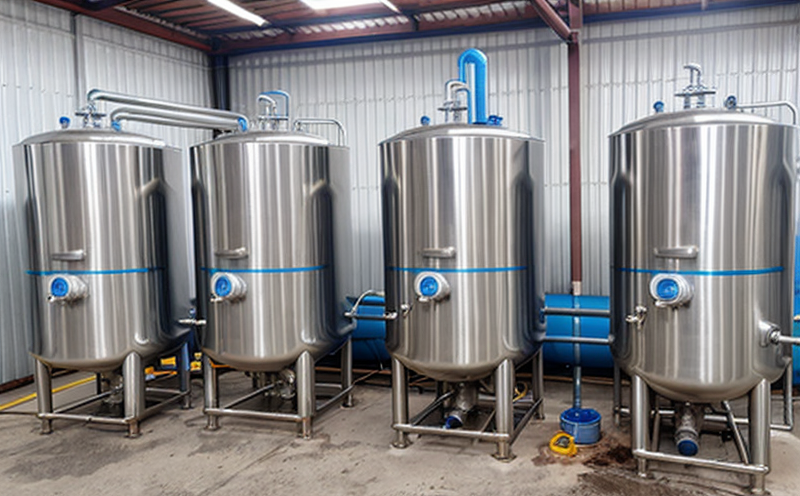ISO 9308-1 E Coli and Coliform Test in Cooling Water
The ISO 9308-1 standard is a widely recognized method for the detection of coliform bacteria, specifically E. coli, in cooling water systems. This test is essential for ensuring that industrial facilities comply with environmental regulations designed to protect public health and minimize the risk of contamination.
Cooling water systems are critical components of many industrial processes, including power generation, manufacturing, and HVAC systems. These systems require frequent monitoring to prevent microbial growth, which can lead to scaling, corrosion, and biofilm formation. The presence of coliform bacteria, particularly E. coli, is an indicator of recent contamination by fecal matter and highlights the potential for pathogenic organisms to be present.
According to ISO 9308-1, coliforms are used as a general indicator organism of the sanitary quality of water intended for human contact or use in food preparation. The test involves incubating samples under specific conditions to observe the growth of coliform bacteria colonies. If E. coli is detected, it indicates that the water has been contaminated by fecal matter within the last few days.
The significance of this test lies in its ability to provide early warnings about potential contamination issues before they escalate into more serious problems. Regular testing helps facilities maintain clean and safe water systems, ensuring compliance with health and safety regulations.
| Applied Standards | Description |
|---|---|
| ISO 9308-1:2016 | This standard provides a procedure for the detection of coliform bacteria in cooling water. |
| ASTM D1982 | An alternative method that can be used alongside ISO standards for coliform testing. |
The test protocol outlined in ISO 9308-1 involves several steps, including sample collection, preparation, and incubation. Samples are typically collected from the cooling water system using sterile containers to avoid contamination during handling. Once collected, samples are transported to a laboratory for analysis within two hours.
After arrival at the lab, the specimens undergo a series of preparatory steps, which may include dilution or enrichment if necessary. The sample is then inoculated onto appropriate media plates designed to promote coliform growth. Incubation takes place under controlled conditions, typically between 35°C and 37°C for approximately 24 hours.
At the end of this period, any colonies that appear are examined macroscopically and microscopically to confirm their identity as coliform bacteria. Positive results indicate the presence of fecal contamination in the water system. Negative results suggest that no recent fecal matter has been introduced into the cooling water.
Understanding the significance of this test is crucial for quality managers, compliance officers, R&D engineers, and procurement personnel responsible for maintaining industrial facilities. By adhering to ISO 9308-1 standards, these professionals can ensure their operations meet stringent health and safety requirements.
Applied Standards
| Standard | Description |
|---|---|
| ISO 9308-1:2016 | This standard provides a procedure for the detection of coliform bacteria in cooling water. |
| ASTM D1982 | An alternative method that can be used alongside ISO standards for coliform testing. |
The use of these internationally recognized standards ensures consistency and reliability across different testing facilities worldwide. Compliance with ISO 9308-1 is particularly important for industries subject to stringent environmental regulations, such as power generation plants, refineries, and large-scale manufacturing facilities.
By adopting this standard, companies demonstrate their commitment to maintaining high-quality water systems that contribute positively to both operational efficiency and public health. This approach not only enhances the reliability of industrial processes but also helps in meeting increasingly stringent environmental standards imposed by regulatory bodies.
Why Choose This Test
The ISO 9308-1 E Coli and Coliform Test is a critical tool for ensuring water quality in cooling systems. By detecting coliform bacteria early, this test allows facilities to take corrective actions before contamination becomes widespread. Early intervention can prevent costly disruptions to production schedules and protect the environment from potential harm.
For compliance officers responsible for meeting regulatory requirements, this test provides peace of mind by offering a reliable method for demonstrating adherence to health and safety standards. R&D engineers benefit from having robust data on water quality trends that can inform process improvements and optimizations.
Procurement personnel involved in selecting suppliers or equipment for cooling systems will appreciate the consistency provided by ISO 9308-1, ensuring that all parties are working towards a common goal of maintaining high-quality water. Quality managers oversee these efforts internally, ensuring that all aspects of operations align with best practices and regulatory expectations.
The test results generated from this procedure are highly valued in industries where water quality is paramount to operational success. The ability to detect E. coli specifically allows for targeted interventions focused on preventing further contamination, thereby reducing the likelihood of broader issues arising within the cooling system.
In summary, choosing the ISO 9308-1 E Coli and Coliform Test ensures that facilities remain compliant with international standards while also enhancing operational efficiency. Early detection capabilities provided by this test enable proactive management strategies aimed at maintaining optimal water quality throughout industrial processes.
International Acceptance and Recognition
- E. coli is widely recognized as a key indicator of fecal contamination in water systems.
- The ISO 9308-1 standard has been adopted by numerous countries around the world, including the United States, Canada, and many European nations.
- This method is recommended for use in industries such as power generation, manufacturing, and food processing where cooling water quality is critical.
- Many regulatory bodies worldwide accept results from this test when evaluating compliance with environmental regulations related to water quality.
The global acceptance of the ISO 9308-1 standard underscores its importance in maintaining consistent practices across different regions. By adhering to these international guidelines, facilities demonstrate their commitment to upholding high standards of hygiene and safety.
Facilities operating under strict environmental regulations may find particular value in using this test as part of their compliance strategy. The widespread recognition ensures that results obtained from ISO 9308-1 are respected globally, facilitating smoother interactions with regulatory authorities and international partners.





